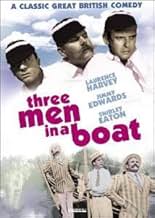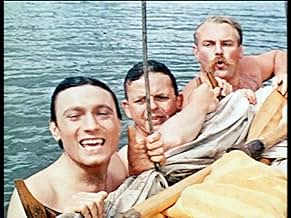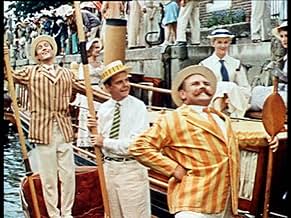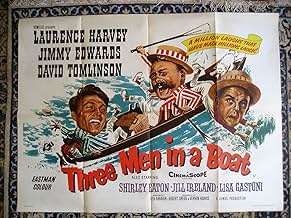Agrega una trama en tu idiomaThree London gentlemen take a vacation rowing down the Thames, encountering various mishaps and misadventures along the way.Three London gentlemen take a vacation rowing down the Thames, encountering various mishaps and misadventures along the way.Three London gentlemen take a vacation rowing down the Thames, encountering various mishaps and misadventures along the way.
- Dirección
- Guionistas
- Elenco
- Nominada a1 premio BAFTA
- 2 nominaciones en total
Opiniones destacadas
Having read most of the other reviews, I do feel that most of the reviewers have missed the point. I seem to be the only person here who's actually read the book (and it's sequel, Three Men on the Bummel), and would suggest that, although the film doesn't follow the book to a 'T' (but then, what film adaptation ever does), it does capture the flavour of JKJ's work-in fact, the opening sequence, the lock sequence and the pineapple chunks sequence are taken almost word-for-word... The setting has been moved forward 30 years or so (the book was published in 1889), and some artistic licence has been taken, but it's all done in good fun-and might entice some people to actually read it... The costumes are fantastic, the girls are wonderful, and , all in all, I should suggest this is well worth a watch on a wet Sunday afternoon... BTW, was Jimmy Edwards born with that moustache?..
The Victorian era seemed like the good old days in the fifties, so the time was right for this Eastman Colour exercise in nostalgia with an agreeable score by John Addison; the Thames and Hampton Court Maze lending themselves well to the CinemaScope format and when national treasures A. E. Matthews, Earnest Thesiger & Miles Malleson put in an appearance lined up horizontally across the screen.
Shirley Eaton, Lisa Gastoni & Jill Ireland are much too modern as the young gentlemen's lady loves and Lawrence Harvey as George seems seriously out of place amidst the general levity, particularly strumming a ukulele; his presence in the cast being accounted for by the influential friend he then had at Romulus Films.
Shirley Eaton, Lisa Gastoni & Jill Ireland are much too modern as the young gentlemen's lady loves and Lawrence Harvey as George seems seriously out of place amidst the general levity, particularly strumming a ukulele; his presence in the cast being accounted for by the influential friend he then had at Romulus Films.
I watched this film for the first time last night and was quite disappointed by it. As someone you has read the book on many occasions I found this film to be a very poor adaption of it. I suppose if you were not trying to compare it with the book it was a fairly decent comedy from the fifties. I did not think think that the casting of Laurence Harvey as George was right though Jimmy Edwards and David Tomlinson seemed to fit into the light hearted romp very well. I think to be fair to the film I was expecting it to be much closer to the book then in fact it was but still it was a good representation of British Cinema from that era.
It was when I saw a 2006 documentary about three friends taking a boat trip on the Thames River to emulate Jerome K. Jerome's story of Three Men in a Boat, that I realized I'd never seen this movie. I recalled hearing about it from my youth but simply never had the opportunity until recently when I got a DVD from my library.
Now, I've not read the actual book but, I understand from other reviews I've read elsewhere, the film narrative bears little relationship to the story that Jerome penned one reviewer even going so far to say that the author would be turning in his grave. No doubt stories from other authors have fared the same or worse.
So, if you have read the story then you may be disappointed. However, as an example of well-produced British humour from the 1950s, it stands the test of time as a light-hearted, albeit cliché-ridden, romp with Jimmy Edwards as Harris, Laurence Harvey as George and the very dapper David Tomlinson as J the surrogate Jerome. For the love interest encountered along the way, the three men meet up with Shirley Eaton as Sophie, Lisa Gastoni as Primose and Jill Ireland as Bluebell.
The story is filmed, essentially, as a series of set pieces, beginning with the Preparations to Take a Trip during which the three are shown for the bumbling idiots they are with a hilarious, but predictable, catastrophic attempts to package up all their supplies, all ending in shambles at the bottom of stairs, with a similar situation as they load it onto the boat, almost capsizing.
However, off they row, and their first port of call is Hampden Court where they decide to experience the Largest Maze in Europe (or so we're told) and, naturally, they get confused and confuse everyone else in the maze with their efforts to lead them out which, naturally, leads to more slapstick humour.
Later that evening, there is Making Camp for the Night, which, being England, is wet, very wet and an occasion for more misery for the trio, and much hilarity for the viewer as they go through all of the mistakes that many people make when erecting tents, building fires, and so forth. During the course of that day, however, they meet up with the three young women and begin the flirtations.
The next day could be captioned the Photo Op whereby, coming upon a large boating fraternity all waiting to get through a lock, and with a local photographer on hand, our intrepid three make further advances towards the women but simply end up on their bums, legs in the air, and their boat in danger of being swamped. Only the quick action of Bluebell saves them by using a boat hook to prevent disaster, thereby enhancing the budding relationships. The three men, however, are caught on camera, much to their chagrin.
In succession, then, there is the Evening Dance, followed by the funniest attempts I've seen to Open a Can of Pineapple at their camp and which has almost the same level of madcap humour as that greatest of all when Basil Fawlty (John Cleese of TV's Fawlty Towers) beats up his Austin car, with a tree branch, for refusing to start. If you've seen that, you know what I mean. Now I wonder if Cleese was influenced by the can of pineapple that wouldn't open?
The next morning, they Take a Dip in the river but skinny-dipping. All goes well, sort of, until a group of women and children decide to have a picnic nearby. Ah, watch how they finally get back on board their boat while retaining modesty. Priceless...
After that, the three manage to Ruin a Racing Eights Race when they cross the river in their boat to reach the women on the other bank; numerous eights are left in shambles with entangled oars, the three blissfully unaware of their transgression. And, the film ends with the old standby: The Cricket Match (only in England, of course) where the three reduce that to chaos, totally, with the help of J's pet dog. I nearly fell off my chair.
Sure, it's a total farce, but that's what the Brits are good at well, in those times, anyway. The acting is top-notch, as you would expect, although I think Laurence Harvey, to be kind, was more suited to dark dramas like Room at the Top (1959), A walk on the wild side (1962), A dandy in aspic (1968) and so on. Comedy seemed a bit of a strain for him. Not so Tomlinson and Edwards, of course.
The script is very funny also, alive with cracking good one-liners, double entendre and heavy irony. The Eastman colour is vibrant, to put it mildly, but it does enhance the scenery and the idyllic settings. The women act well, although they don't share the same amount of screen time as the men. Jill Ireland, of course, went on to appear in Robbery Under Arms (1957) and met her future husband, Charles Bronson, in the process. The film was directed by Ken Annakin, who went on to direct Nor the Moon by Night (1958), Third man on the mountain (1959), co-director on The Longest Day (1962), and followed that by directing The Battle of the Bulge (1965) and others.
Three Men is suitable for all ages, and good for family viewing. Recommended for those who like English humour of the fifties and sixties.
Now, I've not read the actual book but, I understand from other reviews I've read elsewhere, the film narrative bears little relationship to the story that Jerome penned one reviewer even going so far to say that the author would be turning in his grave. No doubt stories from other authors have fared the same or worse.
So, if you have read the story then you may be disappointed. However, as an example of well-produced British humour from the 1950s, it stands the test of time as a light-hearted, albeit cliché-ridden, romp with Jimmy Edwards as Harris, Laurence Harvey as George and the very dapper David Tomlinson as J the surrogate Jerome. For the love interest encountered along the way, the three men meet up with Shirley Eaton as Sophie, Lisa Gastoni as Primose and Jill Ireland as Bluebell.
The story is filmed, essentially, as a series of set pieces, beginning with the Preparations to Take a Trip during which the three are shown for the bumbling idiots they are with a hilarious, but predictable, catastrophic attempts to package up all their supplies, all ending in shambles at the bottom of stairs, with a similar situation as they load it onto the boat, almost capsizing.
However, off they row, and their first port of call is Hampden Court where they decide to experience the Largest Maze in Europe (or so we're told) and, naturally, they get confused and confuse everyone else in the maze with their efforts to lead them out which, naturally, leads to more slapstick humour.
Later that evening, there is Making Camp for the Night, which, being England, is wet, very wet and an occasion for more misery for the trio, and much hilarity for the viewer as they go through all of the mistakes that many people make when erecting tents, building fires, and so forth. During the course of that day, however, they meet up with the three young women and begin the flirtations.
The next day could be captioned the Photo Op whereby, coming upon a large boating fraternity all waiting to get through a lock, and with a local photographer on hand, our intrepid three make further advances towards the women but simply end up on their bums, legs in the air, and their boat in danger of being swamped. Only the quick action of Bluebell saves them by using a boat hook to prevent disaster, thereby enhancing the budding relationships. The three men, however, are caught on camera, much to their chagrin.
In succession, then, there is the Evening Dance, followed by the funniest attempts I've seen to Open a Can of Pineapple at their camp and which has almost the same level of madcap humour as that greatest of all when Basil Fawlty (John Cleese of TV's Fawlty Towers) beats up his Austin car, with a tree branch, for refusing to start. If you've seen that, you know what I mean. Now I wonder if Cleese was influenced by the can of pineapple that wouldn't open?
The next morning, they Take a Dip in the river but skinny-dipping. All goes well, sort of, until a group of women and children decide to have a picnic nearby. Ah, watch how they finally get back on board their boat while retaining modesty. Priceless...
After that, the three manage to Ruin a Racing Eights Race when they cross the river in their boat to reach the women on the other bank; numerous eights are left in shambles with entangled oars, the three blissfully unaware of their transgression. And, the film ends with the old standby: The Cricket Match (only in England, of course) where the three reduce that to chaos, totally, with the help of J's pet dog. I nearly fell off my chair.
Sure, it's a total farce, but that's what the Brits are good at well, in those times, anyway. The acting is top-notch, as you would expect, although I think Laurence Harvey, to be kind, was more suited to dark dramas like Room at the Top (1959), A walk on the wild side (1962), A dandy in aspic (1968) and so on. Comedy seemed a bit of a strain for him. Not so Tomlinson and Edwards, of course.
The script is very funny also, alive with cracking good one-liners, double entendre and heavy irony. The Eastman colour is vibrant, to put it mildly, but it does enhance the scenery and the idyllic settings. The women act well, although they don't share the same amount of screen time as the men. Jill Ireland, of course, went on to appear in Robbery Under Arms (1957) and met her future husband, Charles Bronson, in the process. The film was directed by Ken Annakin, who went on to direct Nor the Moon by Night (1958), Third man on the mountain (1959), co-director on The Longest Day (1962), and followed that by directing The Battle of the Bulge (1965) and others.
Three Men is suitable for all ages, and good for family viewing. Recommended for those who like English humour of the fifties and sixties.
When I saw this film advertised on Talking Pictures, I just had to watch it. I think I saw it as a child many years ago; but in the meantime I had read the book and wanted to compare the interpretation.
To be honest, I didn't find the book that funny despite the opinion of many critics down the years. I had an interest because I'm from Walsall, Jerome K Jerome's home town (didn't his parents have any imagination!). Anyhow, as mentioned elsewhere, the film has little in common with the book. Some of the scenarios used e.g. the picnic, are related as happening to acquaintances rather than the main characters themselves. Having said that, the tin of pineapples scene was pretty faithfully rendered.
So far as casting goes, I think they got it about right. I had no problems with Laurence Harvey as George, and thought he was an effective counter to David Tomlinson's bumbling and Jimmy Edward's bull-in-a-china shop approach. Although the slapstick episodes did become tedious.The females were of course window dressing. Jill Ireland played her vacant self, and Shirley Eaton was a bit too modern for the era. Particularly in the bath scene! Strangely, Lisa Gastoni was the only one who convinced (what happened to her?) Martita Hunt, never a beauty, but always a beautiful performance, gave us her usual character; the matriarch. And I wonder if she was ever in anything other than period costume dramas?
The Hampton Court Maze scene was the best, with a host of British character actors running around wildly trying to get out. In all it wasn't a bad movie. Like the book, it sought to convey a picture of an idyllic England, long-since vanished. Although in reality, such a vision only ever existed for the privileged few. A true representation of the book would be difficult to reproduce, and probably wouldn't be half as interesting. Coincidentally, when I worked at a college some years ago, three students retraced the journey down the Thames in a boat one summer vac. Like in the film, it apparently rained a lot!
¿Sabías que…?
- TriviaA box office disappointment in its native England, the film was nevertheless enthusiastically received in France.
- ErroresAfter the picnic, the mud spatters from the dog on the girl's dress disappear in the medium shot.
- ConexionesVersion of Three Men in a Boat (1920)
Selecciones populares
Inicia sesión para calificar y agrega a la lista de videos para obtener recomendaciones personalizadas
- How long is Three Men in a Boat?Con tecnología de Alexa
Detalles
- Tiempo de ejecución1 hora 31 minutos
- Relación de aspecto
- 2.35 : 1
Contribuir a esta página
Sugiere una edición o agrega el contenido que falta

Principales brechas de datos
By what name was Three Men in a Boat (1956) officially released in India in English?
Responda































